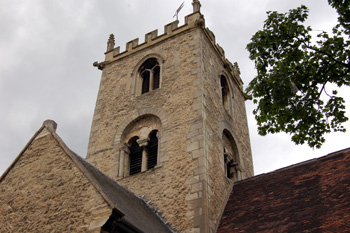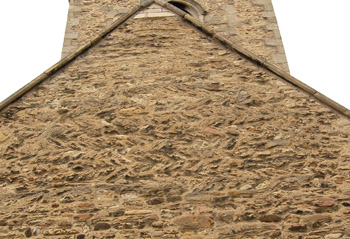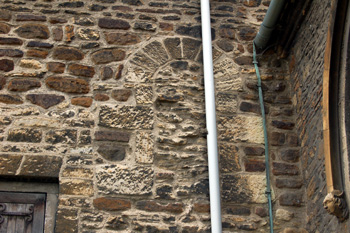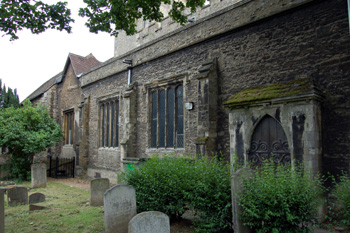
Saint Mary's tower seen from the south, June 2009
The oldest parts of Saint Mary's are Early Norman. These comprise the bulk of the tower, (which stands at the crossing of the nave, chancel and two transepts, north and south) including the arch to the nave inside as well as both transepts and the west end. The first known rector, Warinus, was instituted in 1200 but the Norman masonry is older. There are areas of herringbone masonry to be seen on the outside of the church which probably dates to the second half of the 11th century, and may just pre-date the Norman Conquest. It has been argued [Journal of Bedfordshire Archaeology Volume 9] that the tower is Saxon.

Herringbone work in the south wall of the south transept, June 2009
The south transept is quite interesting. The south wall contains a good bit of herringbone masonry. The east wall contains quite a large Norman window, which is now blocked (and partially hidden by an ugly plastic drain pipe). Inside this window cuts into a smaller round-arched window higher up which corresponds to a similar window in the west wall of the south transept. These are clearly earlier than the Norman window (as it cuts through one of them) and so they may be Anglo-Saxon in date, just before 1066.

Blocked Norman window in the east wall of the south transept, June 2009
The chancel is in the Decorated style and so is early 14th century. Excavations in 1990 showed that the chapel to the north, which held the organ, although rebuilt later, was originally of the same date.
![Sedilia in Saint Mary's [Z1244]](/CommunityHistories/Bedford/BedfordImages/Sedilia in Saint Marys [Z1244].jpg)
Sedilia in Saint Mary's [ref: Z1244]
The sedilia shown above was painted about 1820 by Thomas Fisher in the chancel. The top of the tower is Perpendicular in style, dating to the 15th century.

The north aisle of Saint Mary's, June 2009
The north aisle was added in the 16th century, probably about 1545 following the closure and demolition of the church of Saint Peter Dunstable which stood north of Cauldwell Street and opposite the west end of Saint Mary's in what is today Saint Mary's Square. No doubt stone from Saint Peter Dunstable was reused in building Saint Mary's north aisle.